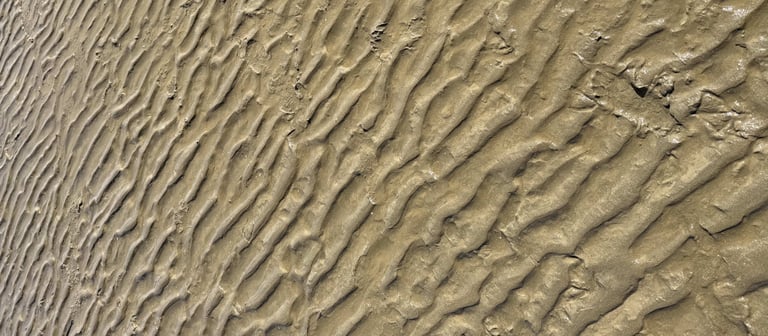Research Festival
Facilitator
Mona Yadav, MA Fine Art: Drawing (UAL)
What this workshop explores
My research studies what water leaves behind and how matter can hold that memory. This workshop lets visitors make and read a low relief made from sand and plaster so that flow and residue can be seen together. The focus is not on an image of water. It is on a field that stores a trace. Drawing is understood as a spatial condition in the room through field, seam and spacing, not as illustration on a page.
How it works
We press simple ripple lines into compacted damp sand, pour plaster, and demould a small white tile that records what remains after movement stops.
Learning aims
• Read a surface as a record of water after it leaves
• Use spacing and seams as drawing within a field
• Understand small flaws or edge chips as records rather than faults
• Document outcomes with one clear overhead photo per cast
Timed session plan, sixty minutes
• 0 to 10 min Welcome, two minute intro to practice, quick demo
• 10 to 15 min Prepare an A6 sand bed in trays, compact flat, press two or three ripple bands with simple tools or hand
• 15 to 20 min Mix plaster at about two to one plaster to water by volume until smooth
• 20 to 40 min Pour into the sand impression, while casts set we look briefly at seams, gaps and pacing
• 40 to 55 min Demould, soft brush clean, title the tile, take one overhead photo on neutral card
• 55 to 60 min Make a small group photo grid, tidy, set all waste to harden before disposal
Materials and quantities, eight participants
• Fine play sand, about ten to fifteen kilograms total, reusable, one spray bottle for misting
• Trays or box lids, eight, A4 to A3 size, plus one demo tray
• One compacting board or flat scrap wood to press the sand level
• Plaster of Paris about three kilograms, clean water, two jugs, eight mixing cups, eight sticks or spatulas
• Simple tools to draw ripples such as popsicle sticks, plastic spoons, old forks, shells or mesh
• Eight soft brushes, labels and markers, paper towels and wipes, one bin bag, old towels
• Neutral board or card for photos, phone or tablet for overhead shots
Clean release note, sand
Compacted damp sand releases cleanly. A few grains may cling and brush off. For the smoothest back face, compact well and mist lightly.
Plaster mixing note
Sprinkle plaster into water until small islands remain, rest for one minute, mix smooth, pour from a low height. Demould when firm to the touch. Do not overfill.
Workshop Plan — Traces of water


Space and setup
Two rows of tables and one small demo station. Nearby water source for mixing. Small surface to place fresh casts. Cover tables, keep floors dry, keep pathways clear.
Access and inclusion
All tasks can be done seated or standing. No fumes, no heat, no sharp tools. Latex free gloves available. Plain language step sheet on each table.
Risk management
• Plaster never pour slurry into sinks, allow waste to harden in bin liners before disposal
• Sand keep slightly damp to limit dust, sweep any spills at once
• Spills wipe immediately to prevent slips, place a small caution sign if needed
• Manual handling split loads of sand, water and plaster into smaller containers
• Fresh casts edges can be slightly sharp, soft brush clean and round any nibs before handing to the public
Documentation and evaluation
• One overhead photo of each tile on a neutral backdrop from a consistent height
• A simple label with participant name and a six word title
• One group photo grid at the end of each session
• After the session I will upload a short selection to my online platform with a one hundred and fifty word reflection on seams, spacing and pace
Participant take away
Each participant leaves with one small white plaster relief tile that records the ripple pattern they pressed. If a tile needs to dry further, a clearly marked drying area will be used for later collection.
How this connects to my research
The workshop is a compact version of my studio method. It keeps evidence visible and treats drawing as a field in space made by seams and distances rather than marks alone. The sand bed acts as ground. The plaster records a trace. The small gap between tiles operates as line the body reads while moving. The aim is careful looking and an ethic of attention and repair that is consistent with my installation practice.
monayadav.com